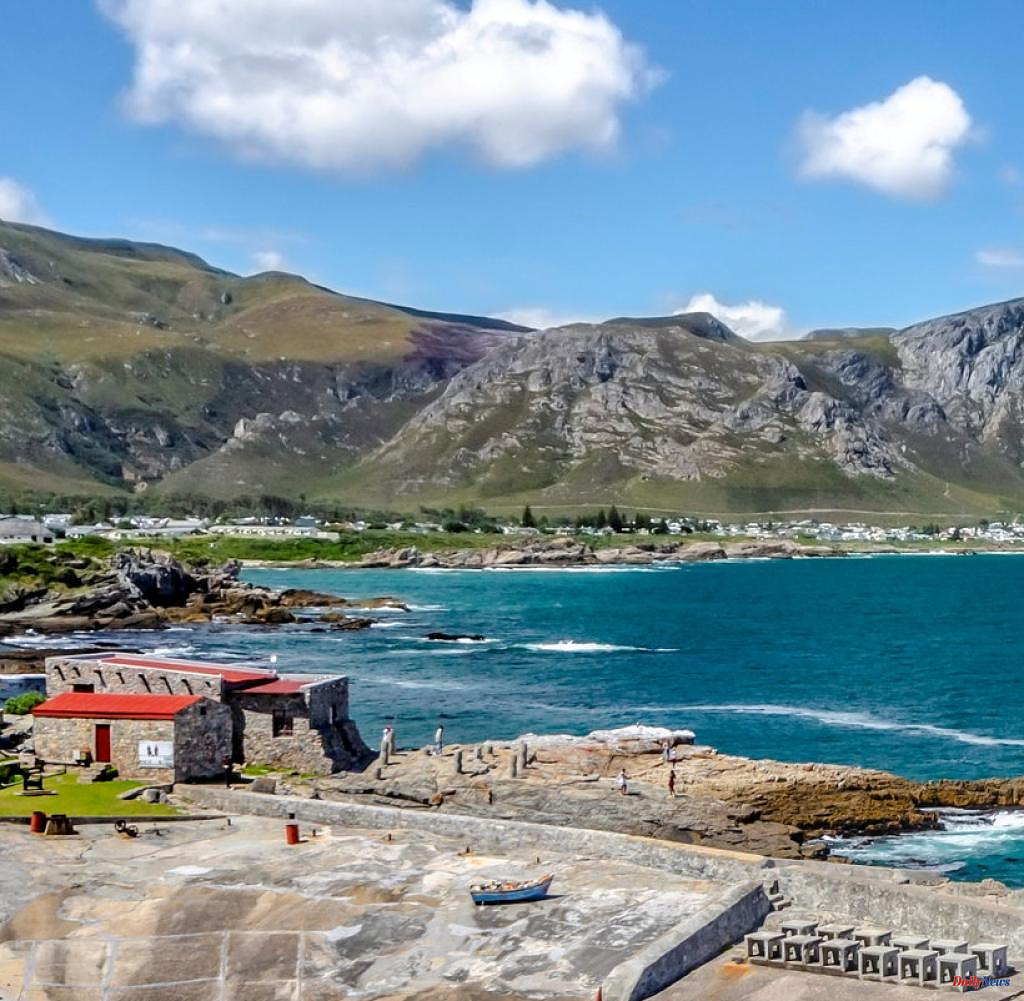Fog lies over Walker Bay at the southern tip of Africa and the sea is choppy. This is typical of the time of year – now is winter in the southern hemisphere. But around noon the sun usually manages to dissolve the heavy veil and you can look across the bay again, from Hermanus to Gansbaai.
The two towns at the upper and lower end of the crescent-shaped bay, two hours south of Cape Town, are like two dissimilar sisters: Hermanus is pretty and prosperous, while Gansbaai, founded by fishermen, is more modest and has long been in a kind of slumber.
Despite the harsh weather, Walker Bay is well visited in the winter months - on land by nature-seeking holidaymakers and in the water by large sea creatures, which come here in large numbers between July and October every year and in turn are the reason for the tourist rush.
Every day during these weeks life explodes here. Up to 18-metre-long southern right whales, Bryde's whales and humpback whales frolic in the northern bay, often in dozens at a time, darting out of the water before splashing into the waves with a roar.
An animal spectacle from which one city in particular has benefited so far: Hermanus. The 33,000-inhabitant town, known far beyond South Africa's borders as a spot for whale watchers, has achieved considerable prosperity, which is reflected in the many pretty holiday homes, but also in the breathtakingly high real estate prices.
"Somewhere else you have to turn on the Discovery Channel on TV or visit aquariums, I just have to look out my living room window," says 75-year-old retiree Suzan Crichton. From her home in Hermanus, she can watch the whales make their stage in Walker Bay, which is warm compared to her Antarctic origins; the water is currently 15 degrees.
If the houses in the posh district of Voelklip form a kind of loge, then in the restaurant "Bientang's Cave" you sit one floor down in the stalls, to stay in theatrical language. The restaurant is housed in a kind of cave vault that has been carved out of the rock over the course of centuries by the storm-lashed waves of the Atlantic. The view of fat whales is free with the meal.
In fact, you can watch the sea giants from many places on the shore: Just sit or stand on the cliffs and wait, at some point a whale or a whole school of whales is guaranteed to come by.
If one shows up, Bulelani Silangwe becomes active: He is "Whale Crier" - the official "whale caller" of Hermanus, who draws the attention of onlookers to the presence of marine mammals in the bay with a long blast. To do this, he blows loudly and distinctly into a horn made from dried kelp algae. The tradition of the whale caller has existed since 1991. It is not known whether the trumpet sound actually attracts the animals because they mistake the signal for whale song, but it is quite unlikely.
About 15 kilometers further south, at the other end of the bay in Gansbaai, you can also watch whales from the cliffs, but hardly anyone does that to this day - Hermanus has successfully defended its reputation as the glamorous "World Whale Capital".
In the poorer Gansbaai, other sea animals were therefore used: because the waters in front of the city have an unusually high density of sharks, from the mid-1990s, when South Africa’s tourism awoke after the end of apartheid, a global reputation as the “shark capital” developed – next to Australia's Ballina and New Smyrna Beach in Florida.
An Austrian woman was attacked by a shark at the Egyptian seaside resort of Hurghada. However, this is a very unusual situation. "It's anything but normal for sharks to attack people," says marine biologist Fabian Ritter.
Source: WORLD
This worked well for decades because in front of Gansbaai, in addition to smaller shark species, great white sharks also made their rounds, specimens up to seven meters long, notorious from bad Hollywood films. On so-called cage diving tours - diving tours where brave tourists are lowered into the bay in cages - you could look the dreaded creature straight in the eyes, including breathtaking photos with the underwater camera. They were lured by bloody bait fed to them within sight of the cages. Before 2017, the Gansbaai spectacle brought up to 180,000 visitors a year.
But since then, the tourist magnet, i.e. the great white shark, has hardly been seen. The reason for this are whales, more precisely: a pair of orcas, which were given the names Port and Starboard on site.
As in the Namibian town of Lüderitz years before, the killer whales in Walker Bay have been massacring great white sharks since 2017. Several carcasses with their livers bitten out, targeted by the orcas, floated face down or washed ashore. The intelligent predatory fish that managed to escape the orcas have avoided the bay ever since. "Before that, when this happened before, great whites abruptly disappeared from the entire region for years," confirms Alison Kock, a Cape Town marine biologist.
Shark cage tours still exist, but now you have to settle for smaller species of sharks. But they are not harmless, otherwise the obligatory safety instructions would hardly warn against sticking limbs through the cage bars.
The participants drive in groups about 20 minutes out into the bay where the shark safari boat anchors. Dressed in diving gear, five people climb into a cage attached to the side of the ship. It sinks so far into the water that the occupants' heads just peek out.
Two crew members begin dumping buckets of fish waste over the heads of the caged shark watchers, and the first predators are already approaching. "Sharks are coming from the right, go down and look out!" shouted from above.
Almost synchronously, everyone in the group sticks their heads into the murky water from the remains of fish and watches through diving goggles as a group of bronze sharks eat themselves into a frenzy. Even if no great white shark can be seen: the greedy bronze sharks, which can be up to three meters long, are just as capable of sending shivers down the viewer's spine.
In the meantime, people in Gansbaai want to move away from pure shark tourism. "With the disappearance of the Great Whites and the Covid crisis, we started to position ourselves differently," says Glenda Kitley of the local tourist office. “What makes Gansbaai really magical is the intact nature and the tranquillity. Here, for example, it is possible to walk along the beach without meeting a single person.” That is not possible in lively Hermanus at the other end of the bay, where cafes and bars are lined up.
A detour into the hinterland is also part of the nature experience around Gansbaai. There, the large mammals such as rhino, hippopotamus and elephant, which used to be in large numbers here, have long since disappeared. Still, the area has its charms, the real attraction taking place on a much smaller stage. We are talking about the vegetation along the Cape coast, the so-called fynbos, a gem that is unique in the world.
The term fynbos comes from Afrikaans and can be translated as "fine bush". In an area a little smaller than Lower Saxony, there are over 7,000 species of ferns and flowering plants, more than half of which only thrive here. All of Lower Saxony, on the other hand, has only 1,700 plant species, and none of them are endemic. In addition to the many plants, thousands of species of insects, amphibians and reptiles live in the fynbos, as well as fascinating bird species such as Cape nigger, paradise flycatcher, Knysna woodpecker and whistle shrike.
One person who discovered the magic of this almost untouched bush landscape very early on is Michael Lutzeyer. In 1991, South Africa's transformation was already becoming apparent, when the German-South African bought Grootbos - a farm on the north-eastern edge of Gansbaai. Here Lutzeyer began systematically with a demolition: over the years, nature was able to reclaim the pastures that had eaten their way into the landscape. Lutzeyer later turned Grootbos into a private nature reserve with lodges.
"For me, the special appeal of this area is not so much the spectacular animal observation, South Africa has more to offer elsewhere anyway," says the 70-year-old. "It's about preserving an endangered piece of nature." Which is why, in addition to the Grootbos reserve, whose area now measures 3,500 hectares, he also maintains a foundation that is intended to continue researching and preserving the fynbos.
The next morning there is fog again over Walker Bay, again the winter sun will dissipate it in the next few hours. On Grootbos, Michael Lutzeyer sits on his terrace having morning tea and watches one of the rare bontebok grazing peacefully in the fynbos.
Sometimes klipspringers, Cape porcupines or chakras baboons make an appearance. However, nobody on Grootbos has yet seen the real star of the local wildlife: the extremely shy and very rare Cape leopard. The chance of a sighting is about the same as winning the lottery.
At Hermanus, at the head of the bay, whale-caller Bulelani Silangwe honks his horn and welcomes some particularly lively humpback whales. And in the Marina of Gansbaai, the providers of Cage Diving Tours are preparing their boats for the next excursions. They hope that great white sharks will soon be on their doorstep again - the first specimens have already been sighted off Muizenberg and Fish Hoek, a bay further north.
Arrival: Lufthansa, for example, flies non-stop from Frankfurt to Cape Town. Transfer flights are offered by KLM (via Amsterdam) or Turkish Airlines (via Istanbul).
Accommodation: In Hermanus: "The Marine Hotel" directly on the cliff path, whale sightings possible directly from the room, double rooms from 224 euros (themarinehotel.co.za).
In Stanford: The "White Water Farm" between Hermanus and Gansbaai offers luxurious country house charm, double rooms from 86 euros per day with a minimum stay of two days (whitewaterfarm.co.za).
Near Gansbaai: On the grounds of the Grootbos Private Nature Reserve you live luxuriously in the middle of nature, you can choose between "Garden Lodge", "Forest Lodge" and private villas, a lodge for two costs from 893 euros per day including meals, transfers and excursions (grootbos.com).
More information: South African Tourism, southafrica.net
Participation in the trip was supported by Grootbo's Private Nature Reserve. You can find our standards of transparency and journalistic independence at axelspringer.com/de/Werte/downloads.












